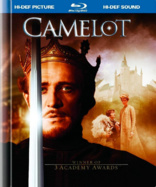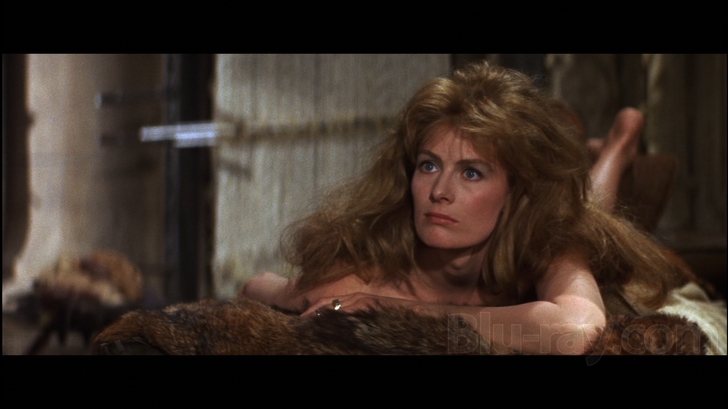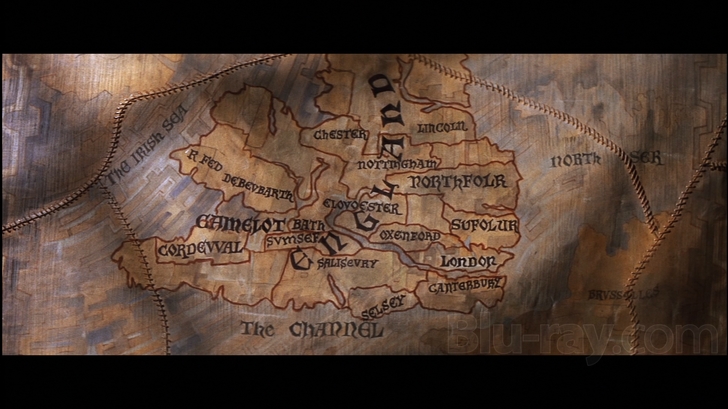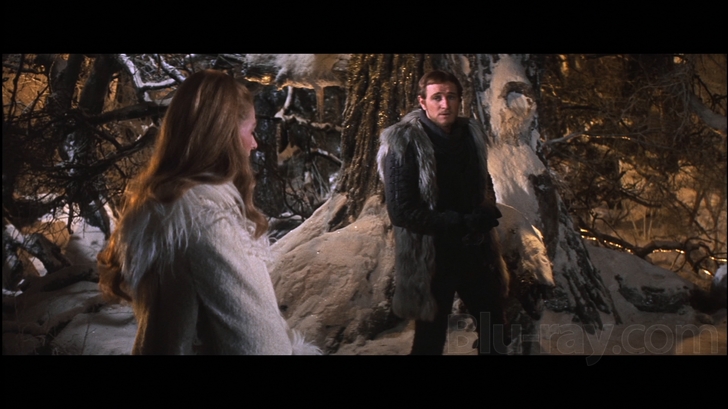Camelot Blu-ray Movie
HomeCamelot Blu-ray Movie 
Blu-ray + CDWarner Bros. | 1967 | 180 min | Rated G | Apr 24, 2012

Movie rating
6.6 | / 10 |
Blu-ray rating
| Users | 0.0 | |
| Reviewer | 4.0 | |
| Overall | 4.0 |
Overview
Camelot (1967)
Based on T.H. White's The Once and Future King, this lavish film adaptation of the hit Broadway musical celebrates a fleeting, mythical time of love and chivalry--the reign of King Arthur and the Knights of The Round Table. Although torn apart by the conflicts between passion, love, honor and duty, it was a golden era that could have been... and could yet be.
Starring: Richard Harris (I), Vanessa Redgrave, Franco Nero, David Hemmings, Lionel JeffriesDirector: Joshua Logan
| Romance | Uncertain |
| Musical | Uncertain |
| Drama | Uncertain |
| Fantasy | Uncertain |
| Comedy | Uncertain |
| Adventure | Uncertain |
Specifications
Video
Video codec: MPEG-4 AVC
Video resolution: 1080p
Aspect ratio: 2.40:1
Original aspect ratio: 2.35:1
Audio
English: DTS-HD Master Audio 5.1 (48kHz, 24-bit)
Subtitles
English SDH, French, Spanish
Discs
50GB Blu-ray Disc
Two-disc set (1 BD, 1 CD)
Playback
Region free
Review
Rating summary
| Movie | 3.5 | |
| Video | 4.0 | |
| Audio | 4.5 | |
| Extras | 3.5 | |
| Overall | 4.0 |
Camelot Blu-ray Movie Review
Not so brief but definitely shining.
Reviewed by Jeffrey Kauffman April 12, 2012What a difference a mere two or three years make. In 1964 Jack Warner experienced one of the greatest triumphs of
his
long and storied career, when his production of the classic Lerner and Loewe musical My Fair Lady took home a
bevy of Academy Awards, including Best Picture and Best Actor. Yes, there had been some controversy (considerable,
considering the more demure era back then) about the casting of Audrey Hepburn over Julie Andrews in the role of Eliza
Doolittle, but ultimately audiences didn’t seem to mind all that much, and the film became one of the crown jewels of the
Warner Brothers pantheon, raking in huge profits and proving that Warner, not exactly known for its glamorous
musicals, could do them as well as anyone. A year later, Oscar bestowed its Best Picture award on yet another musical,
one starring Julie Andrews in fact, the legendary The Sound of Music, which was if anything an even bigger hit
than My Fair Lady had been. And so it seemed like a surefire recipe for lightning striking twice (or even thrice)
when Warner started moving ahead with plans for yet another sumptuous big budget musical based on a significant
stage hit by Lerner and Loewe (not so coincidentally having starred Julie Andrews in its Broadway incarnation), the
musicalization of the Arthurian legends Camelot.
But something ineffable had changed between 1964 – 65 and
1967, when Camelot opened (it's kind of interesting to note that no real blockbuster film musicals opened in
1966). Though we weren’t quite at the timeframe of multiple assassinations and,
later, the cynicism of Watergate, the roiling political atmosphere of Vietnam had definitely become more prevalent, and
the incipient “youth culture” movement seemed to be collectively thumbing its nose at any traditional fare that had once
been considered “surefire”. Camelot in fact attempted to trade in on the nascent hippie movement with a PR
campaign highlighting the almost “summer of love” ethos of the Arthur – Guinevere – Lancelot triangle, replete
with baroque poster art by the then very popular Bob Peak (kind of the poor man’s Peter Max). (Unfortunately the Peak
poster art is nowhere to be found on this new release, a real shame.) But another
starcrossed set of lovers, Bonnie and Clyde (ironically another Warner Brothers release), ended up being the
pairing that 1967 audiences wanted to see, and though there would continue to be some huge musicals continuing to
be produced for the next several years, the handwriting was already on the wall for the once vaunted genre.

How do you follow up what was generally agreed was perhaps the greatest musical of all time and which was at that point inarguably the most successful musical of its era? That was the quandary facing Lerner and Loewe after My Fair Lady opened on Broadway and became a critics’ darling and a box office sensation. When Camelot opened on Broadway in 1960, it was instantly obvious that lightning hadn’t exactly struck twice. Despite the fact that the show bears perhaps Lerner and Loewe’s most sumptuous score, a set of songs probably more ravishing than even those of My Fair Lady, the stage play was hampered by an overly talky book that may have been extremely literate and even poetic, but made the proceedings awfully draggy. For those of you who have seen the stage version of Camelot, you know that it is not unusual for the first act of the musical alone to run around two hours, the full running time of many another show. There’s also the simple fact that Camelot is by its very nature something of a downer. After all, the “storybook” marriage of Arthur (Richard Harris) and Guinevere (Vanessa Redgrave) soon devolves into a ménage a trois with erstwhile Knight of the Round Table Lancelot (Franco Nero), ultimately leading to the demise of the fabled kingdom. Not especially the stuff of “happily ever after,” the typical course that musicals take.
Jack Warner was convinced that Camelot would be another My Fair Lady, and he poured enormous time, effort and of course moolah into the production, bringing in a trio of then very hot younger stars in Harris, Redgrave and Nero. Directing duties were handed over to Joshua Logan, a pro in both the Broadway stage and film worlds, though one who had taken more than a few brickbats for his helming of the film adaptation of the legendary Rodgers and Hammerstein musical South Pacific. Logan attempted to connect to this legendary material with an unusual gambit of zooms and virtually nonstop close-ups, two elements distinctly at odds with the epic nature of the film, not to mention its widescreen format. Audiences were largely nonplussed, though the film managed to eke out three Academy Award wins in the technical categories, including for its gorgeous sets and costumes as well as the absolutely captivating score adaptation helmed by the iconic Alfred Newman and his associate Ken Darby.
Looking back now from the vantage point of 45 years since the film’s original release, Camelot bears the flaws of its source material but is still an immensely enjoyable enterprise, due largely to the charisma of the three leads (Redgrave in particular has never been more appealing nor more sensationally beautiful) and an truly impressive production design. While the film is as overlong as its stage progenitor (it clocks in at around three hours), some subtle reshifting and revisioning by Lerner (who wrote the screenplay) adds to the film’s emotional resonance, especially since the “happily ever after” is now told as a flashback from a decidedly less than happy perspective. The highlight of the film is still undoubtedly the incredibly lovely Lerner and Loewe song score, which is brought to life with some of the best work of Alfred Newman’s long and storied career. The wedding scene in particular is a textbook example of brilliant orchestration (listen to those evocative massed recorders) and impeccable vocal arranging (courtesy of Ken Darby).
It’s rather fascinating to realize that the melancholy that hangs over much of Camelot serves as a particularly apt epitaph for an era of film musicals which was about to come to a crashing halt, as a number of high profile lumbering adaptations of Broadway hits (as well as some misguided originals) would soon put an end to the genre. Camelot serves as both a prime example of some of the mistakes that were made as the sixties were drawing to a close, as well as a potent reminder of just how lush and glamorous musicals could be in the hands of expert craftsmen. A new generation has replaced the stately charms of Camelot with a quick cut ethos that may be more attention grabbing, but may just as well be more forgettable.
Camelot Blu-ray Movie, Video Quality 

Camelot is presented on Blu-ray courtesy of Warner Brothers with an AVC encoded 1080p transfer in 2.40:1. This high definition presentation is certainly a welcome relief after the disappointing My Fair Lady, another Lerner and Loewe musical classic which really deserved better treatment. This is a largely satisfying release that may only be faulted (if indeed it should be faulted at all) for reproducing anomalies that were in the original film elements to begin with. The first thing that first time viewers will notice about Camelot is how relentlessly dark it is, for the bulk of its first half hour at least. (Take a look at Screencap 6 for a good example—that's Richard Harris' face in there somewhere, if you can actually make it out.) The film is frequently gauzily soft, intentionally so, which may lead some who have never seen the film theatrically to assume there's a problem with the transfer—there isn't. While the first section of the film is impossibly dark, at about the 30 minute mark, things perk up dramatically, at which point fine detail also increases exponentially. One thing eagle eyed viewers may also notice is the strange preference for browns and oranges in the color scheme of the film, meaning there aren't really many bright primaries that instantly pop off the screen and scream "high definition". The good news here is the original look of the film has been well served with this transfer; grain is intact, the image is perfectly filmic (if not "sharp" in current parlance), and contrast and black levels are consistent and solid.
Camelot Blu-ray Movie, Audio Quality 

Oh, the glories of this soundtrack! Camelot is presented with a lush and lovely lossless DTS-HD Master Audio 5.1 track that springs elegantly to life in the film's many musical sequences. There has been some internet scuttlebutt about problems with the stems or source material used for home video releases, but judging by the quality of the audio on this Blu-ray, any supposed "problems" have evidently been solved. Newman and Darby were reaching the end of their long and storied collaboration (Darby would follow up Camelot with equally winning work on 1968's flopola Finian's Rainbow), and their craft and care is noticeable in every bar of the song score and the equally evocative underscore. (As mentioned in the supplements section, the absence of an Isolated Score on this release—especially when it was included on the DVD—is unconscionable.) Fidelity is superb, though dubbing and lip synching are sometimes more than obvious. The high end retains a thin layer of hiss, which is perfectly acceptable and normal for a film of this vintage. Dialogue is very cleanly and clearly presented, and dynamic range is superb throughout the film. The stems bear no appreciable damage and overall this is a stellar lossless presentation that should delight lovers of the Camelot score.
Camelot Blu-ray Movie, Special Features and Extras 

While there's a new commentary and featurette, as well as the two featurettes that were on the previously released DVD, it's a major disappointment that this release does not include the Isolated Score track (even in Dolby Digital 5.1, if need be) that was on the DVD release.
- Commentary by Stephen Farber. Farber provides an interesting and in-depth commentary that covers aspects of both the Broadway and Hollywood incarnations of Camelot, though his quavering voice may remind some of the inimitable Martin Short's old Saturday Night Live routine where he played Katharine Hepburn's supposed grand-nephew Nelson.
- Camelot: Falling Kingdoms (HD; 29:59) is a really well done mini-documentary paralleling the declining fortunes of Jack Warner and Warner Brothers with the bittersweet end of Camelot as well as the wistful nostalgia revolving around the Kennedy Era. This features a wealth of fascinating and informative interviews and provides a wealth of background on the production.
- The Story of Camelot (SD; 9:45) is a vintage featurette that starts with archaeologists digging in England for the "real" Camelot and then segues into a standard puff piece on the production of the film.
- The World Premiere of Camelot (SD; 29:04) is a nice time capsule taking us back to 1967 for the gala premiere of the film. This has some pretty funny original commercials touting the new "Camelot line" of clothing.
- Trailers includes:
Theatrical Trailer #1 (SD; 2:06)
Theatrical Trailer #2 (SD; 1:04)
Theatrical Trailer #3 (SD; 3:10)
Theatrical Trailer #4 (SD; 3:17)
Theatrical Trailer #5 (SD; 00:26) - CD Containing Four Songs from the Score
Camelot Blu-ray Movie, Overall Score and Recommendation 

Yes, it's too long (maybe even way too long). Yes, it attempts to cater to the Youth Movement, as it was politely termed by the Silent Majority back in the day. Yes, it's full of too many close-ups and vertigo inducing zooms. But, ultimately, who cares? Camelot, for all its flaws (and I'm the last person to deny it's full of flaws) is a treasure of a film, a relic of a bygone age when impeccable craftsmen brought a lifetime of experience to making a huge, stunningly beautiful, film. If you've never seen Camelot before, there's no better way than to start with this largely delightful new Blu-ray. If you have seen the film before, it will be like renewing an old friendship, only better than you remember. With solid video and audio, and some great supplements (despite the appalling lack of an Isolated Score), this release comes Highly recommended.
Other editions
Camelot: Other Editions
Similar titles
Similar titles you might also like

Flower Drum Song
1961

Road to Rio
1947

The Pirate
Warner Archive Collection
1948

Finian's Rainbow
Warner Archive Collection
1968

One Touch of Venus
1948

A Star Is Born
1976

Viva Las Vegas
50th Anniversary
1964

On a Clear Day You Can See Forever
1970

State Fair
1945

Romance on the High Seas
Warner Archive Collection
1948

Glee: The Complete First Season
2009-2010

Let's Make Love
Limited Edition to 3000
1960

Saawariya
2007

Dance, Girl, Dance
1940

Funny Girl 4K
1968

The Pirate Movie
1982

Hello, Dolly!
Fox Studio Classics
1969

It's Always Fair Weather
Warner Archive Collection
1955

Funny Lady
Limited Edition to 3000 - SOLD OUT
1975

In the Good Old Summertime
Warner Archive Collection
1949

